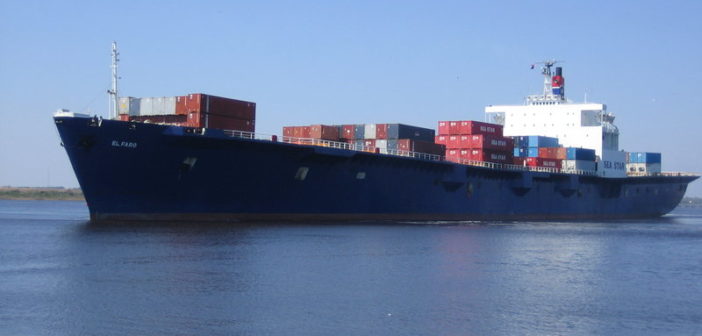An interesting story can be ruined if it is not told well. This is the problem I have with a lot of nonfiction books I read. The pacing of the story — the most important part — is uneven in many nonfiction works.
I’m happy to say that George Michelsen Foy, who wrote the new book, “Run the Storm”, the story of the wreck of the 790' roll on/roll off containership El Faro in October 2015, mostly avoids this problem.
Foy meticulously lays out the story of the worn out freight carrier that sailed into Hurricane Joaquin on Oct. 1, 2015, and wound up at the bottom of the Atlantic Ocean.

The new book is well researched and written. Jacket photo courtesy of Simon & Schuster
The final voyage of El Faro has been well documented. The ship, which regularly sailed from Jacksonville, Fla., to San Juan, Puerto Rico, left the Florida port just as tropical storm Joaquin was gaining strength and growing into a hurricane. The ship’s captain, Michael Davidson, was locked into a particular weather forecast that was as much as 12 hours old and told him he was south of the storm when the ship was actually north of it. As a result, he headed directly into the cyclone that would eventually send the ship, with 30 crewmembers aboard, to the ocean floor more than 15,000′ below.
There is enough blame for the disaster to go around (in particular, Capt. Davidson, Tote Maritime, the ship’s owner and the American Bureau of Shipping, El Faro’s classification society that signed off on its seaworthiness). Most who read WorkBoat and other maritime publications know this because the findings of the U.S. Coast Guard and the National Transportation Safety Board have been well documented. But this book is not only for those who follow the industry. It’s also for those who have never heard of El Faro and don’t know her story.
Although necessary, trying to bring maritime neophytes up to speed slows the momentum of the story telling at times. Foy is not able to fold these explanations smoothly enough into the action with the likes of a Clive Cussler, for example. But then who is? It’s a small problem in the end, but worth mentioning.
In spite of all the hard work that has gone into investigating the disaster, do any of us know exactly what happened? Foy thinks he has come as close as anyone to knowing.
“… there are no witnesses to recount exactly what happened to El Faro as she went into the storm,” Foy writes in an “Author’s Note” that preceeds the text. “The VDR (voyage data recorder) gives us a tremendously useful and accurate tool to track decisions and anxiety levels on the bridge, so when an action is clearly implied by both a conversation and the overall likelihood of its taking place — such as when a navigating officer points out course details, implying that he or she is looking at a chart — that action is described accordingly.”

Author George Michelsen Foy. Photo Courtesy of Simon & Schuster
Where Foy really shines is when “Run the Storm” gives us a look at those left behind — the families of the 30 dead crewmembers. He interviewed some of them, and their stories are compelling to say the least.
Jack E. Jackson was a 60-year-old able seaman aboard El Faro. He had shipped out on the vessel many times and thought it was a rust bucket. Foy talked to Jackson’s brother, Glen, whose telephone conversation with his brother about a month before the ship went down caused him some concern. “Usually he called when he was in Jacksonville, we talked for three, four minutes. This time [Sept. 8, 2015] I was in Lowe’s or Home Depot, and we talked for 45, 50 minutes. For the first time, he said, ‘Man, I think I’m gonna get off [the ship].’ He never broke a contract before, but he was seriously concerned.”
Laurie Randolph Bobillot, mother of El Faro’s second mate, Danielle L. Randolph, 34, received an email from her daughter one hour before the ship’s last signals were received. “I don’t know if you’ve been following the weather, but there’s a hurricane out here and we’re heading straight into it. Winds are super bad and waves not great. Love to everyone,” Randolph wrote.
“She never, ever signed letters or emails with ‘Love, Danielle,’ ” her mother said. “When I read that, I knew she was gone.”
Aboard El Faro’s final voyage was a riding gang of Polish workers who were there to enhance their maritime skills. Among them was Piotr M. Krause, 27, from Gdynia, Poland. His wife, Anna, moved out of the apartment that she shared with Piotr after the tragedy because she could not stand to be there without him. The Krauses have a son who is three years old now. She told Foy that sometimes when there is a hard decision to make, she goes for a walk on the beach and tries to imagine what her husband would advise her to do. But the nights are the hardest. “Behind the windows is a strong wind, which will always give me anxiety. The wind always brings me back to that place in the dark, empty ocean, to my husband.”




